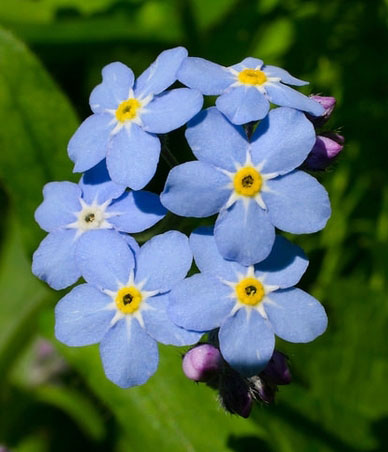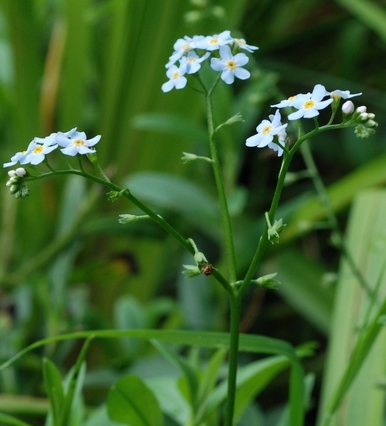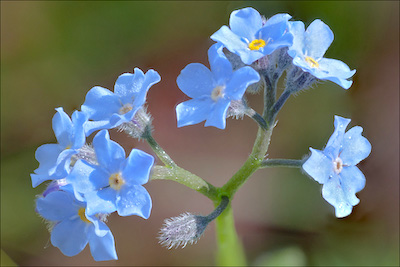Forget-Me-Not: A Flower Filled with Symbolism and Lore
By Linda Puff, Fairfax Master Gardener

Myosotis sylvatica
How did this little blue flower get its name? One story is of two lovers living on opposite sides of the river. The young man wanted to cross the river to be with his lady. He jumped in and swam as hard as he could, but the current was too strong. When he reached the other side, he grabbed some flowers growing on the bank, but they came away in his grasp. While he clutched the small blue flowers in his hand, the river carried him away, and he shouted, “Forget-Me-Not!”
A similar story is set in 15th century Germany where a knight and his lady were walking along the Danube River, and he picked some blue flowers by the river for his love. He fell in and was swept away. He tossed the flowers to her and cried out, “Forget-Me-Not!” It is said she wore the flowers in her hair until she died. In medieval times, ladies wore these flowers to show their faithfulness and enduring love.
Forget-me-nots, Myosotis sylvatica, are small blue flowers. When there are only one or two plants, they are rather boring, so plant lots of them and let them reseed. They become a lovely sea of blue. How often are we looking for blue in our landscape! Myosotis comes from the Greek “mouse’s ear,” as its leaves resemble mouse ears. They come in different colors from pink to white to orange, but the flower is most commonly associated with a bluish purple color. The woodland forget-me-not, is one of the more common types found in the garden. The variety, Myosotis scorpiodes, is sometimes called “scorpion grass,” which seems like an unusual name for such a pretty little flower. The name comes from how the plant grows with emerging clusters of flowers bent in the curl of a scorpion’s tail. There are currently 74 different species of forget-me-nots all over the world.

Myosotis scorpioides
Forget-me-nots, delicate blue flowers featuring yellow throats, are prolific bloomers and will flower throughout most of the growing season. They are self-sowers and make excellent ground covers over time. They can be used in pots, on porches or patios and are perfect for cottage, woodland and rock gardens.
Forget-me-nots are usually biennials and will take two years to complete their growing cycle of flowering and producing seed. They will die back in the winter and re-sprout in the spring. Once in your garden, you won’t have to re-seed. Buy a packet of seed by early summer. Choose a spot in the garden and prepare the soil, raking to loosen and smooth it out. In mid-summer, spread the seeds. Water lightly afterward and often enough to keep the soil moist. Seedlings will pop up by fall; blooming will occur the following spring. If you have picked a good location for them, they will bloom between May and October each year thereafter. With proper care, forget-me-nots could last for decades.
As cute as these flowers are, they can take over a garden. If you want a large patch, let them sow from year to year. Otherwise, they must be managed. Control their growth by removing them in places where they are not supposed to extend and shape them into your desired landscape bed design. Deadhead spent blooms and any seedheads that form to stop unwanted spread. Because the flowers reseed readily, forget-me-nots are invasive and considered a noxious weed in the Midwest, one of the U.S. regions where it has naturalized.
Forget-me-nots love rich, consistently moist, well-drained soil. Watering with a soaking hose or drip irrigation makes the watering process the easiest. Use a slow release fertilizer. True forget-me-nots perform well in zones 5 to 9. Common cultivars thrive in zones 3 to 8. At the southern end of its range, give the forget-me-nots afternoon shade. In the north, they can grow in full sun or partial shade. The more sunlight they receive, the more water they will need. Garden pests leave forget-me-nots alone. They are susceptible to two diseases: powdery mildew and rust. Both diseases thrive in damp environments. Avoid overhead watering. Deer and rabbits do not feed on forget-me-nots. Butterflies are attracted to them.
Forget-me-nots are linked to rich history around the world. During World War II, the FreeMasons of Europe chose the forget-me-not as a symbol of their work. This provided an outward means of identification while lessening the risk of possible recognition in public by the Nazis, who were engaged in wholesale confiscation of all Masonic Lodge properties.
Forget-me-nots symbolize true love and respect. If a gift, these tiny flowers represent a promise that you will always remember the person and keep them in your thoughts. In Newfoundland, the forget-me-not represents those who fell in World War I.
The forget-me-not is also the symbol for International Missing Children’s Day. The Alzheimer’s Society uses forget-me-nots as symbols for memory loss and to raise awareness for the disease.
The forget-me-not is the symbol of protection and luck and has the power to protect humans against witches. King Henry IV of England used this flower symbol as his lucky charm during his exile in 1398. These flowers became his symbol after he returned to England with them.
The forget-me-not represents long lasting connections not only between lovers but also friends. This connection cannot be broken or shaken by anything or anyone. The forget-me-not also joins the aster and morning glory as birth flowers for the month of September.

Myosotis alpestris
In the first months of 1926, Alaska’s territorial Governor George Parks was working hard for the cause of statehood. While in Washington, D.C., he saw the flags of the 48 states flying outside the Old Post Office Building and after talking with the postmaster general, he was convinced that Alaska also needed a flag to fly with the others. He persuaded the Alaska American Legion to hold a contest open to all Alaskan children grades 7 to 12 to design a flag for the territory. A 13- year-old 7th grader was the winner. “The blue field is for the Alaska sky and the forget-me-not, an Alaskan flower. The North Star is for the future state of Alaska, the most northerly in the union. The dipper is for the Great Bear, symbolizing strength.” When Alaska entered the Union in 1959 as the 49th state, the alpine forget-me-not, Myosotis alpestris, was adopted as the official state flower and floral emblem.
Prominent in literature, the forget-me-not appears in poems, epics and novels. It can be found in the works of Henry David Thoreau and J.R.R. Tolkien. In a German tale, when the Lord had finished naming all the plants, a small plant cried out, “Forget-Me-Not, O Lord!” He said, “That shall be your name!”
The forget-me-not with its small true blue flowers and nostalgic charm has a meaning of its own. It is based on a rich history filled with folklore and symbolism and makes a lovely addition to a mixed border garden.
Resources
• Of Naked Ladies and Forget-Me-Nots, The Stories Behind the Common Names of Some of our
Favorite Plants by Allan M. Armitage
• Forget-Me-Nots: Tips and Symbolism of These Pretty Blue Flowers, Amber Kanuchel, Farmers’
Almanac
• How to Grow and Care for Forget-Me-Nots, David Beaulieu, The Spruce
• Forget-Me-Nots, Joey Williamson, Home and Garden Information Center, Clemson Cooperative
Extension
• Forget-Me-Nots, Alaska.org